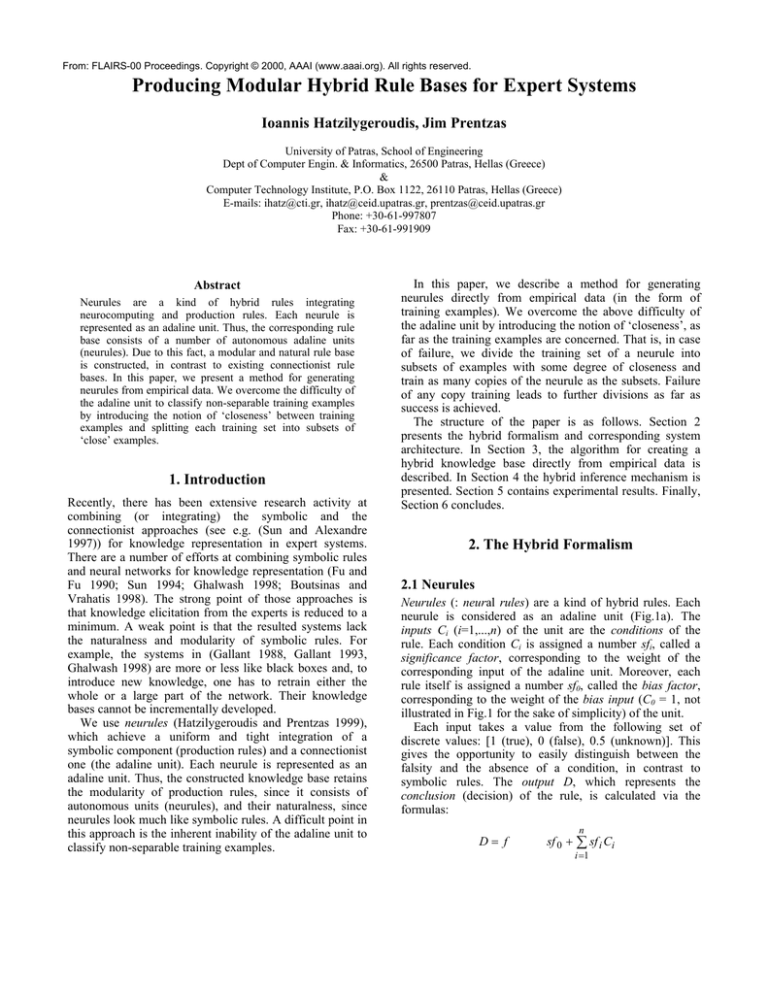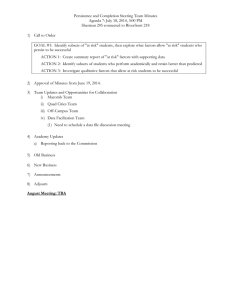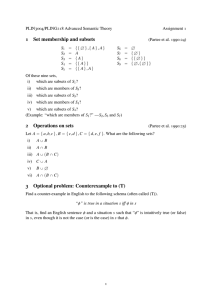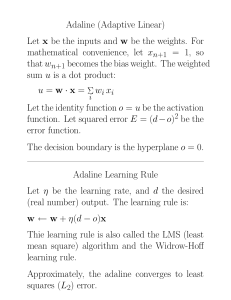
From: FLAIRS-00 Proceedings. Copyright © 2000, AAAI (www.aaai.org). All rights reserved.
Producing Modular Hybrid Rule Bases for Expert Systems
Ioannis Hatzilygeroudis, Jim Prentzas
University of Patras, School of Engineering
Dept of Computer Engin. & Informatics, 26500 Patras, Hellas (Greece)
&
Computer Technology Institute, P.O. Box 1122, 26110 Patras, Hellas (Greece)
E-mails: ihatz@cti.gr, ihatz@ceid.upatras.gr, prentzas@ceid.upatras.gr
Phone: +30-61-997807
Fax: +30-61-991909
Abstract
Neurules are a kind of hybrid rules integrating
neurocomputing and production rules. Each neurule is
represented as an adaline unit. Thus, the corresponding rule
base consists of a number of autonomous adaline units
(neurules). Due to this fact, a modular and natural rule base
is constructed, in contrast to existing connectionist rule
bases. In this paper, we present a method for generating
neurules from empirical data. We overcome the difficulty of
the adaline unit to classify non-separable training examples
by introducing the notion of ‘closeness’ between training
examples and splitting each training set into subsets of
‘close’ examples.
1. Introduction
Recently, there has been extensive research activity at
combining (or integrating) the symbolic and the
connectionist approaches (see e.g. (Sun and Alexandre
1997)) for knowledge representation in expert systems.
There are a number of efforts at combining symbolic rules
and neural networks for knowledge representation (Fu and
Fu 1990; Sun 1994; Ghalwash 1998; Boutsinas and
Vrahatis 1998). The strong point of those approaches is
that knowledge elicitation from the experts is reduced to a
minimum. A weak point is that the resulted systems lack
the naturalness and modularity of symbolic rules. For
example, the systems in (Gallant 1988, Gallant 1993,
Ghalwash 1998) are more or less like black boxes and, to
introduce new knowledge, one has to retrain either the
whole or a large part of the network. Their knowledge
bases cannot be incrementally developed.
We use neurules (Hatzilygeroudis and Prentzas 1999),
which achieve a uniform and tight integration of a
symbolic component (production rules) and a connectionist
one (the adaline unit). Each neurule is represented as an
adaline unit. Thus, the constructed knowledge base retains
the modularity of production rules, since it consists of
autonomous units (neurules), and their naturalness, since
neurules look much like symbolic rules. A difficult point in
this approach is the inherent inability of the adaline unit to
classify non-separable training examples.
In this paper, we describe a method for generating
neurules directly from empirical data (in the form of
training examples). We overcome the above difficulty of
the adaline unit by introducing the notion of ‘closeness’, as
far as the training examples are concerned. That is, in case
of failure, we divide the training set of a neurule into
subsets of examples with some degree of closeness and
train as many copies of the neurule as the subsets. Failure
of any copy training leads to further divisions as far as
success is achieved.
The structure of the paper is as follows. Section 2
presents the hybrid formalism and corresponding system
architecture. In Section 3, the algorithm for creating a
hybrid knowledge base directly from empirical data is
described. In Section 4 the hybrid inference mechanism is
presented. Section 5 contains experimental results. Finally,
Section 6 concludes.
2. The Hybrid Formalism
2.1 Neurules
Neurules (: neural rules) are a kind of hybrid rules. Each
neurule is considered as an adaline unit (Fig.1a). The
inputs Ci (i=1,...,n) of the unit are the conditions of the
rule. Each condition Ci is assigned a number sfi, called a
significance factor, corresponding to the weight of the
corresponding input of the adaline unit. Moreover, each
rule itself is assigned a number sf0, called the bias factor,
corresponding to the weight of the bias input (C0 = 1, not
illustrated in Fig.1 for the sake of simplicity) of the unit.
Each input takes a value from the following set of
discrete values: [1 (true), 0 (false), 0.5 (unknown)]. This
gives the opportunity to easily distinguish between the
falsity and the absence of a condition, in contrast to
symbolic rules. The output D, which represents the
conclusion (decision) of the rule, is calculated via the
formulas:
n
D = f (a), a=sf 0 + ∑ sf i Ci
i =1
as usual (see e.g. Gallant 1993), where a is the activation
value and f(x) the activation function, which is a threshold
function (Fig.1b). Hence, the output can take one of two
values, ‘-1’ and ‘1’, representing failure and success of the
rule respectively.
D
f(x)
(sf0)
1
(sf1)
C1
(sfn)
(sf2)
...
C2
0
x
The HRB contains neurules produced from empirical
(training) data (see Section 3). The initial neurules,
constructed by the user, are trained using the training
mechanism (TRM) and the training examples produced
from the available empirical data. The HIM is responsible
for making inferences by taking into account the input data
in the WM and the rules in the HRB. The WM contains
facts. A fact has the same format as a condition/conclusion
of a rule, however, it can have as value the special symbol
“unknown”. Facts represent either initial conditions or
intermediate/final conclusions produced during an
inference course.
-1
Input data
Cn
(a)
(b)
Fig.1 (a) A neurule as an adaline unit (b) the activation
function
Final conclusions
WM
Facts
Neurules
HRB
HIM
2.2 Syntax and Semantics
The general syntax (structure) of a rule is (where ‘{ }’
denotes zero, one or more occurrences and ‘< >’ denotes
non-terminal symbols):
<rule>::= (<bias-factor>) if <conditions>
then <conclusions>
<conditions>::= <condition> {, <condition>}
<conclusions>::= <conclusion> {, <conclusion>}
<condition>::= <variable> <l-predicate> <value>
(<significance-factor>)
<conclusion>::= <variable> <r-predicate> <value>
where <variable> denotes a variable, that is a symbol
representing a concept in the domain, e.g. ‘sex’, ‘pain’ etc,
in a medical domain. A variable in a condition can be
either an input variable or an intermediate variable,
whereas a variable in a conclusion can be either an
intermediate or an output variable. An input variable takes
values from the user (input data), whereas intermediate and
output variables take values through inference, since they
represent intermediate and final conclusions respectively.
<l-predicate> denotes a symbolic or a numeric predicate.
The symbolic predicates are {is, isnot}, whereas the
numeric predicates are {<, >, =}. <r-predicate> can only
be a symbolic predicate. <value> denotes a value. It can be
a symbol or a number. The significance factor of a
condition represents the significance (weight) of the
condition in drawing the conclusion(s).
2.3 The Hybrid Architecture
In Fig.2, the architecture of the hybrid rule-based expert
system to incorporate neurules is illustrated. The run-time
system (in the dashed rectangle) consists of three modules,
functionally similar to those of a conventional rule-based
system: the hybrid rule base (HRB), the hybrid inference
mechanism (HIM) and the working memory (WM).
Training data
TRM
Initial neurules
Fig.2 The hybrid expert system architecture
3. Hybrid Rule Base Construction from
Empirical Data
The algorithm for constructing a hybrid rule base from
empirical data (training examples) is outlined below:
1. Construct a neurule for each of the intermediate and
final conclusions (variables). These neurules will be
referred to as initial neurules.
2. Use the training examples to train each initial neurule.
After training, one or more neurules will be produced
from each initial neurule.
3. Put the produced neurules into the hybrid rule base.
In the sequel, we elaborate on each of the first two steps
of the algorithm.
3.1 Constructing the Initial Neurules
In constructing a neurule, all conditions, corresponding to
the input and intermediate variables that contribute in
drawing a conclusion, which corresponds to an
intermediate or an output variable, constitute the inputs of
a rule and the conclusion its output. Dependency
information for intermediate or output variables, that is
information about which input variables they depend on, is
very useful. Thus, one has to produce as many rules as the
different conclusions, intermediate and final to be drawn.
For example, in the medical diagnosis domain, if there are
four symptoms expressed by the conditions C1, C2, C3, C4
and two diseases D1, D2, such that D1 depends on C1, C2,
C3 and D2 on C3, C4, the following initial neurules are
constructed: “(0) if C1 (0), C2 (0), C3 (0) then D1”, “(0) if
C3 (0), C4 (0) then D2”. A zero initial value is assigned to
each factor by default, except if the user assigns non-zero
ones.
3.2 Training the Initial Neurules
From the initial training examples, we produce as many
subsets as the initial neurules. Each subset contains
examples of the form [v1 v2 … vn d], where vi, i= 1, …,n
are their component values, which correspond to the n
inputs of the neurule, and d is the desired output (‘1’ for
success, ‘-1’ for failure). Each subset is used to train the
corresponding initial neurule and calculate its factors. The
learning algorithm employed is the standard least mean
square (LMS).
However, there are cases where the LMS algorithm fails
to specify the right significance factors for a number of
neurules. That is, the corresponding adaline units of those
rules do not correctly classify some of the training
examples. This means that the training examples
correspond to a non-separable (boolean) function. It is
known that the adaline model cannot fully represent such
functions.
To overcome this problem, the set of the training
examples used to train the initial neurule is divided into
subsets in a way that each subset contains examples, which
are “close” to each other in some degree. The degree of
closeness between two examples is defined as the number
of common component values. For example, the degree of
closeness of [1 0 1 1 1] and [1 1 0 1 1] is ‘2’. Initially, the
set is partitioned into subsets with low degree of closeness,
e.g. ‘1’. To each subset, the examples of the other subsets
with d =‘-1’ are added, to avoid rule misfiring. Then, as
many copies of the initial neurule as the number of the
subsets are trained. If the factors of a copy misclassify
some of its examples, the corresponding subset is further
partitioned into smaller subsets with examples of the next
greater degree of closeness. This continues, until all
examples are classified.
Therefore, step 2 of the algorithm for each initial neurule
is analyzed as follows:
2.1 From the initial training examples, produce as many
subsets as the number of the initial neurules.
2.2 Train each initial neurule by using the corresponding
training subset. If the calculated factors classify
correctly all the examples produce the corresponding
neurule. Otherwise, divide the training subset into
further subsets of examples with a degree of closeness
equal to ‘1’. Add to each subset the examples with d=-1
of all other subsets.
2.3 For each new subset do the following:
2.3.1 Perform training of a copy of the corresponding
neurule and calculate its factors.
2.3.2 If the calculated factors misclassify examples
belonging to the subset, further divide the subset into
smaller subsets of examples with degree of closeness
increased by one and apply step 2.2 recursively to these
new subsets.
4. The Inference Mechanism
The hybrid inference mechanism (HIM) implements the
way neurules co-operate to reach a conclusion. It is based
on a backward chaining strategy. As soon as the input data
is given and put in the WM, the rules having an output
variable in their conclusion are considered for evaluation.
One of them is selected for evaluation. Rule selection is
based on textual order. A rule succeeds if the output of the
corresponding adaline unit is computed to be ‘1’, after
evaluation of its conditions (inputs).
A condition evaluates to ‘true’, if it matches a fact in the
WM, that is there is a fact with the same variable, predicate
and value. A condition evaluates to ‘unknown’, if there is a
fact with the same variable, predicate and ‘unknown’ as its
value. A condition cannot be evaluated if there is no fact in
the WM with the same variable. In this case, either a
question is made to the user to provide data for the
variable, in case of an input variable, or a rule in HRB with
a conclusion containing that variable is examined, in case
of an intermediate variable. A condition evaluates to ‘false’
if there is a fact in the WM with the same variable,
predicate and different value, in case of an input variable,
and additionally there is no rule in the HRB that has a
conclusion with the same variable, in case of an
intermediate variable. Inference stops either when a rule
with an output variable is fired (success) or there is no
further action (failure).
To increase inference efficiency, a number of heuristics
are used (Hatzilygeroudis and Prentzas 1999).
5. Experimental Results
We applied the algorithm for constructing a hybrid
knowledge base to two different sets of training examples.
The first set, taken from (Mitchell 1997), is illustrated in
Table 1. Here, the target attribute (output variable)
PlayTennis, which can have values Yes or No, should be
predicted based on the values of other attributes (input
variables) concerning the environment.
There are two conclusions that can be drawn: (1)
Playtennis is Yes and (2) PlayTennis is No. Thus, two
initial neurules were produced, which were successfully
trained. All the examples that came out from the rows of
Table 1 were used in training of both neurules, but with
inverse desired outputs. Finally, neurules PTR1 and PTR2
(see below) were produced. A few of the initial conditions
in each neurule were removed, because their factors were
near to zero and had no effect on the conclusion, like e.g.
‘Temperature is Hot’.
Outlook
Sunny
Sunny
Overcast
Rain
Rain
Rain
Overcast
Sunny
Sunny
Rain
Sunny
Overcast
Overcast
Rain
Temperature
Hot
Hot
Hot
Mild
Cool
Cool
Cool
Mild
Cool
Mild
Mild
Mild
Hot
Mild
Table 1
Humidity
Wind
High
High
High
High
Normal
Normal
Normal
High
Normal
Normal
Normal
High
Normal
High
Weak
Strong
Weak
Weak
Weak
Strong
Strong
Weak
Weak
Weak
Strong
Strong
Weak
Strong
PlayTennis
No
No
Yes
Yes
Yes
No
Yes
No
Yes
Yes
Yes
Yes
Yes
No
PTR1: (-0.4) if Humidity is High (-8.5),
Outlook is Sunny (-7.2),
Wind is Strong (-6.0),
Temperature is Cool (-4.9),
Outlook is Overcast (10.0),
Humidity is Normal (8.8),
Temperature is Mild (7.9),
Wind is Weak (5.0)
then PlayTennis is Yes
PTR2: (0.8) if Outlook is Sunny (7.3),
Humidity is High (6.5),
Wind is Strong (6.3),
Temperature is Cool (4.5),
Outlook is Rain (3.8),
Humidity is Normal (-7.5),
Temperature is Mild (-7.0),
Wind is Weak (-6.3)
then PlayTennis is No
The second set of training examples was taken from
(Gallant 1988; Gallant 1993). They deal with acute
theoretical diseases of the sarcophagus. There are six
symptoms (Swollen feet, Red ears, Hair loss, Dizziness,
Sensitive aretha, Placibin allergy), two diseases
(Supercilliosis, Namastosis) whose diagnoses are based on
the symptoms and three possible treatments (Placibin,
Biramibio, Posiboost). Also, a dependency information is
provided.
So, there are two intermediate (the two diseases) and
three final conclusions (the three treatments) to be drawn
producing thus, five initial neurules. The training subsets,
which were extracted from the examples provided in
(Gallant 1988, 1993), and the corresponding neurules (DR1
to DR6) that were produced, are illustrated in the following
tables.
The calculated factors of the initial neurule pertaining to
the treatment Posiboost failed to classify its respective set
of training examples (table DR5-6), because they
correspond to a non-separable function (XOR type). Thus,
two subsets were created containing the first three and the
last three examples respectively. Finally, two neurules
were produced (DR5, DR6). The calculated factors of the
other initial neurules successfully classified their
corresponding set of training examples. Also, although a
few examples containing unknown inputs were omitted,
they were successfully classified.
DR1
RedEars
1
0
0
1
0
1
SwollenFeet
1
0
0
1
1
0
HairLoss
Dizziness
1
0
1
0
1
0
1
0
0
1
HairLoss
1
0
1
0
0
1
Supercilliosis
1
-1
1
-1
1
-1
DR2
SensitiveAretha
1
1
0
1
0
Namastosis
1
1
-1
-1
1
DR3
PlacibinAllergy
0
0
1
0
0
1
1
Supercilliosis
Namastosis
Placibin
0
1
1
0
1
1
0
1
0
1
0
1
0
1
1
1
-1
-1
1
-1
-1
DR4
HairLoss
1
0
1
0
0
1
Superscilliosis
1
0
1
0
1
0
Namastosis
0
1
1
0
1
1
Biramibio
-1
1
-1
-1
1
-1
DR5-6
Placibin
Biramibio
Posiboost
1
1
0
0
0
1
0
1
1
-1
-1
1
DR1: (-0.4) if RedEars is true (-4.4),
SwollenFeet is true (3.6),
HairLoss is true (2.7)
then Disease is Supercilliosis
DR2: (-2.2) if Dizziness is true (4.6),
SensitiveAretha is true (1.8),
HairLoss is true (0.9)
then Disease is Namastosis
DR3: (-0.4) if PlacibinAllergy is true (-5.4),
Disease is Namastosis (1.8),
Disease is Supercilliosis (1.0)
then Treatment is Placibin
DR4: (-0.4) if HairLoss is true (-3.6),
Disease is Namastosis (1.8),
Disease is Supercilliosis (1.0)
then Treatment is Biramibio
DR5: (-0.4) if Treatment is Biramibio (-4.4),
Treatment is Placibin (1.8)
then Treatment is Posiboost
DR6: (-0.4) if Treatment is Placibin (-3.6),
Treatment is Biramibio (1.0)
then Treatment is Posiboost
A comparison between this hybrid rule base and the
equivalent connectionist knowledge base in (Gallant 1988;
Gallant 1993; Ghalwash 1998) demonstrates the
advantages of neurules. It is clear that the benefits of
symbolic rule-based representation, such as naturalness and
modularity are retained. Neurules are understandable, since
significance factors represent the contribution of
corresponding conditions in drawing the conclusion. Also,
one can easily add new or remove old neurules making
small or even no changes to the knowledge base, since
neurules are functionally independent units. Thus,
incremental development of the knowledge base is still
supported, although by larger knowledge chunks.
On the other hand, the equivalent connectionist
knowledge base in (Gallant 1988; Gallant 1993; Ghalwash
1998) is a multilevel network with some meaningless
intermediate units. Thus, it lacks the naturalness of
neurules. Furthermore, there are difficulties in introducing
new or removing existing knowledge from the knowledge
base. These actions entail changes to the knowledge base
that may scale up to the retraining of the whole network,
especially in cases of non-easy learning problems.
6. Conclusion
In this paper, we introduce a method for generating a kind
of hybrid rules called neurules from empirical data.
Neurules integrate neurocomputing and production rules.
Each neurule is represented as an adaline unit. Thus, the
corresponding rule base consists of a number of
autonomous adaline units (neurules). In this way, the
produced rule base retains the modularity of symbolic rule
bases. This is in contrast to existing connectionist rule
bases, which are more or less black boxes and thus do not
allow for incremental development.
A difficult point in our approach is the inherent inability
of the adaline unit to classify non-separable training
examples. We overcome this difficulty by introducing the
notion of ‘closeness’, as far as the training examples are
concerned. That is, in case of failure, we divide the training
set of each neurule into subsets of ‘close’ examples and
train as many copies of the neurule as the subsets. Failure
of any copy training leads to further division until success
is achieved.
Also, the naturalness of symbolic rules is retained in a
degree, since significance factors represent the contribution
of corresponding conditions in drawing the conclusion, a
fact that makes sense.
References
Boutsinas, B., and Vrahatis, M. N. 1998. Nonmonotonic
Connectionist Expert Systems. In Proceedings of the
Second WSES/IEEE/IMACS International Conference on
Circuits, Systems and Computers, Athens, Greece.
Fu, L-M, and Fu, L-C, 1990. Mapping rule-based systems
into neural architecture, Knowledge-Based Systems, 3:4856.
Gallant, S.I. 1988. Connectionist expert systems,
Communications of the ACM, 31(2):152-169.
Gallant, S.I. 1993. Neural Network Learning and Expert
Systems, MIT Press.
Ghalwash, A. Z. 1998. A Recency Inference Engine for
Connectionist Knowledge Bases, Applied Intelligence,
9:201-215.
Hatzilygeroudis, I. and Prentzas, J. 1999. Neurules:
Improving the Performance of Symbolic Rules. In
Proceedings of the Eleventh IEEE International
Conference on Tools with Artificial Intelligence (TAI’99),
417-424.
Mitchell, T. 1997. Machine Learning, McGraw-Hill.
Sun, R. 1994. Integrating Rules and Connectionism for
Robust Commonsense Reasoning, Sixth-Generation
Computer Technology, John Wiley & Sons.
Sun, R., and Alexandre, E. eds. 1997. ConnectionistSymbolic Integration: From Unified to Hybrid Approaches,
Lawrence Erlbaum.








